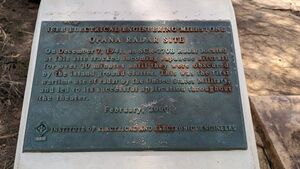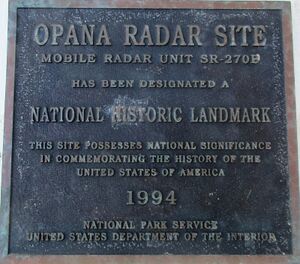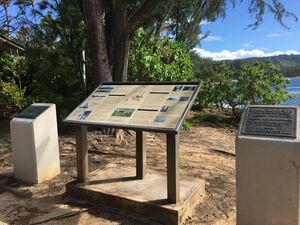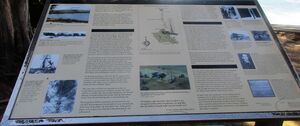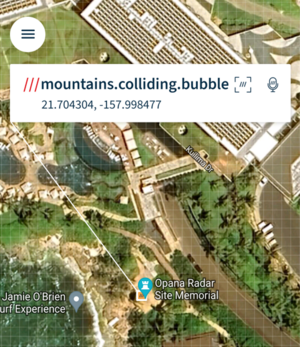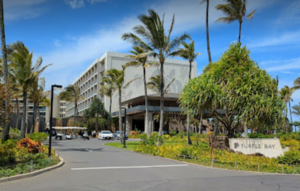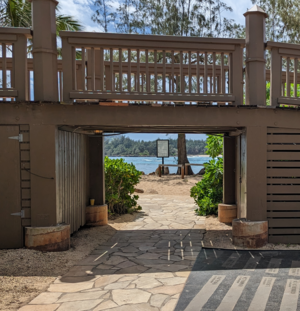Milestones:Opana Radar Site, 1941
Opana Radar Site, 1941
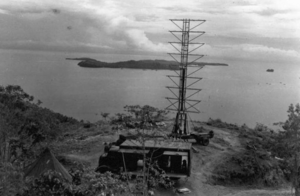
Kuhuku, Hawaii, USA, February 2000 - IEEE Hawaii Section
On December 7, 1941, an SCR-270b radar located at this site tracked incoming Japanese aircraft for over 30 minutes until they were obscured by the island ground clutter. This was the first wartime use of radar by the United States military, and led to its successful application throughout the theater.
Street address
57-091 Kamehameha Highway (State Route 83), Kahuku, Hawaii 96731 US (GPS: 21.704304, -157.998477)
Details of the physical location of the plaque
On the north shore of Oahu is the Turtle Bay Resort Hotel, which is on the beach and adjacent to the Opana Radar Site. Turn off the highway, heading north toward the resort and park in the large parking lot. To the left of the main driveway accessing the hotel is a narrow driveway marked with a "Loading Dock" sign. Walk down that driveway, and turn left to walk under an elevated wooden pedestrian walkway to gain access to the beach. Then on your left you will see the Opana Radar Site, which includes (left to right) a concrete monument with the IEEE plaque, a storyboard explaining this site, and another concrete monument with a National Historic Landmark plaque.
How the plaque site is protected/secured
24/7 access.
Historical significance
THE SCR-270 RADAR
by Frederick G. Suffield 1
Work on this first long-range search radar started at the Signal Corps laboratories at Fort Monmouth, New Jersey, in about 1937. A production contract was let to the Westinghouse Electronics Division in Baltimore, Maryland in 1940. And on December 7, 1941, this was the radar that detected the incoming aircraft at Pearl Harbor. Sadly enough, hardly anyone understood the capability or made use of the radar data up to and including December 7th.
The radar, by today's standards, would be classified as crude, but considering our lack of knowledge of pulses, high frequency, pulse modulators, displays, human factors, etc., it was a surprisingly good unit. It maximum range, 150 miles, and consistent echoes were received at this range. When sited on a cliff or bluff, echoes beyond 150 miles were received.
The operating frequency was 106 megacycles, a high frequency for 1940. With a wavelength of about 9 feet, propellers on aircraft became excellent reflectors. The entire radar occupied four trucks. One of these van type trucks housed the generator and the transmitter power supply. Another was a stake body truck that carried the antenna elements when the radar was being moved. A third was a prime mover that pulled the antenna mount. The fourth was the operating van, it housed the transmitter, modulator, receiver and indicator.
To describe the contents of each truck, one should start with the power unit. This housed a 76 horsepower gas engine driving a 31KW three-phase 60-cycle generator. The engine exhaust went straight up, through a rather ineffective muffler, out the roof of the truck. The transmitter power supply was a monster. It was about 4' high, 5' wide and 6' deep, and only supplied 15KV at .5 amp from a full wave rectifier, a choke and a .5 mfd capacitor. Clever design points in the power supply involved design of the type 531 rectifier tube, about 3" diameter and 7" long. The bottom, at the plate connection, was a cast finned structure that seated into a 3" diameter ring mounted directly on top of the high voltage insulators on the transformer, thus, no plate leads, caps, insulation and support problems.
The antenna tower unfolded from its transportation position to be a triangular tapering tower rising 55' above a circular 8' diameter base. The base plate was remotely rotatable, from the operating truck, thus, steering the antenna. The actual elements were a series of 36 half wave dipoles, arranged in three bays, each bay had 3 strings of horizontally polarized 4 pairs of dipoles, all 36 backed with reflectors. All tuning on early models was by shorting bars on parallel lines and line stretching "trombone" sections. In 1940 there was serious doubt that a 106-megacycle antenna could be designed, built, assembled and tuned in a factory. Westinghouse had a field station on Sandy Hook, New Jersey, offering a distant view over the water entrance to New York Harbor to three large gas storage tanks in Brooklyn. The antenna tower was physically aimed towards the center tank, the radar put on the air, and one man watched the scope in the operating truck, and one climbed the antenna tower with a 4' length of 1 x 2 wood stick. The man on the tower banged away at trombone sections and shorting bars and the man 150' away yelled at him to indicate improvement in the target. When the center tank was a good target and the side one small, the antenna was tuned! The antenna was then rotated to look towards the Glen L. Martin plant in Baltimore, where they almost always had aircraft in the air in test. This provided a crosscheck on performance and opportunity for final tune up. After about 25 sets, we had enough data to pre-position most adjustments, and ultimately went to a screen reflector and pre-cut elements.
The tower was rotated by controls from the operating position, and RF was carried on a 3" spaced copper tube parallel line to the base of the tower in a resonant line condition, terminating in a single turn loop at the base coupled to another single turn loop feeding up the tower. For those accustomed to reading azimuth from the rim of a PP1 scope or from digital read out, we had a different system. We had 3" high numbers painted on plates attached to the 8' diameter rotating tower base and read the azimuth through a window from the operating truck, using at times binoculars, or just plain estimating if mud obscured the numbers.
The heart of the system was of course the Operating Van. The transmitter used two water cooled triodes, type 530, resonant plate line, with the grids held off at about -4500 volts, pulsed up to "0" bias to oscillate. The 15KV-plate voltage required a dual wound ceramic coil to isolate the plates from the grounded water supply, distilled water to minimize leakage current and the addition of ethyl alcohol in the winter as anti freeze.
The receiver was a superheterodyne, with a special tube, the A-5588-A, an RCA experimental electron multiplier, in the front end. While Westinghouse built the modulator, power supply, transmitter and other items, RCA supplied the receiver and I believe Colonial and RCA the indicators.
Each operating van had a spare receiver and spare scope; otherwise, everything was so conservatively designed that service was almost unheard of, except for occasional tube replacement in the modulator.
1. Fred Suffield (1920-2001) was a Life Fellow of the IEEE. His Fellows citation reads: "For contributions to airborne radar development and eminent service to the IEEE". Fred worked for Westinghouse, where he contributed to the airborne television relay system, the Navy AN/APS-6 radar and the SCR-270 radar used at Pearl Harbor. He held 14 patents and published over 30 papers on radar, command and control, lasers, and air defense. He worked on the first radar installed in a Presidential aircraft. (He authored this paper in 1995.)
A Day that will live in infamy!
At 7:02am, on 7 December 1941, two soldiers who were operating an SCR-270 RADAR set at Opana Station on Oahu, Hawaii detected a large flight of planes approaching Oahu from the north at a distance of 136 miles. One of the operators, Joseph Lockard, telephoned the information center at Fort Shafter and reported the incoming planes. Joe McDonald manned the switchboard that morning, and he was sure that this call was serious. The warning was ignored and minutes later Hickam Field was hit by the first bombs of the Japanese attack on Pearl Harbor.
References
- Sam Stitzer, "Signal Progress: Early Developments in U.S. Radar TR Switching" IEEE Microwave Magazine, June 2017
- Opana Radar Site (part of the National Park Service's Pearl Harbor National Memorial)
